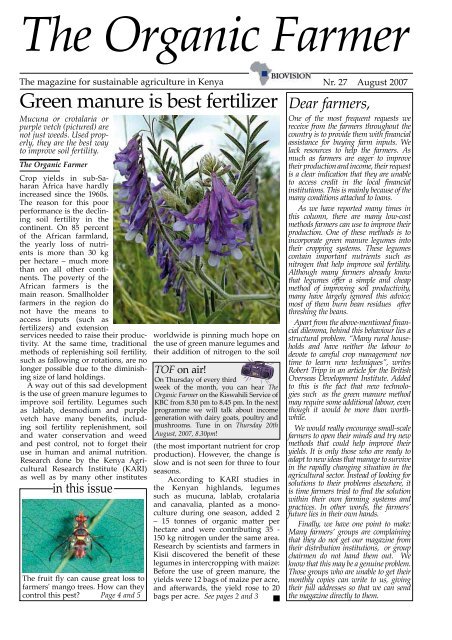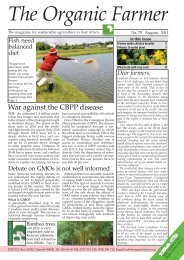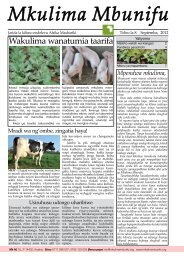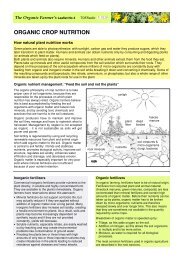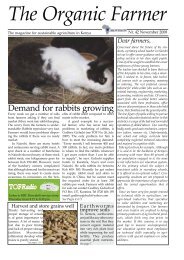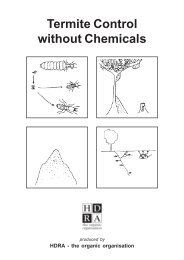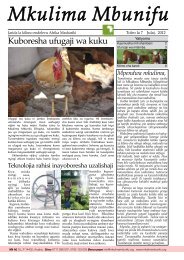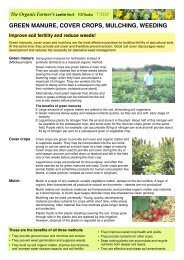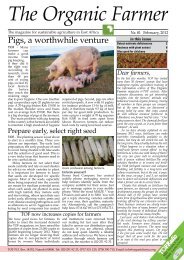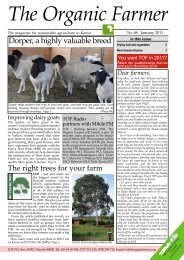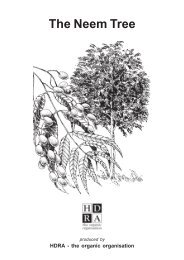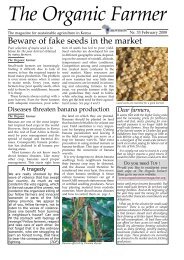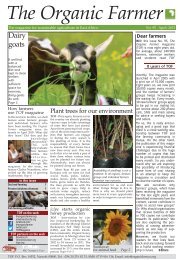Green manure is best fertilizer - Infonet-Biovision
Green manure is best fertilizer - Infonet-Biovision
Green manure is best fertilizer - Infonet-Biovision
You also want an ePaper? Increase the reach of your titles
YUMPU automatically turns print PDFs into web optimized ePapers that Google loves.
The magazine for sustainable agriculture in Kenya<br />
<strong>Green</strong> <strong>manure</strong> <strong>is</strong> <strong>best</strong> <strong>fertilizer</strong><br />
Mucuna or crotalaria or<br />
purple vetch (pictured) are<br />
not just weeds. Used properly,<br />
they are the <strong>best</strong> way<br />
to improve soil fertility.<br />
The Organic Farmer<br />
Crop yields in sub-Saharan<br />
Africa have hardly<br />
increased since the 1960s.<br />
The reason for th<strong>is</strong> poor<br />
performance <strong>is</strong> the declining<br />
soil fertility in the<br />
continent. On 85 percent<br />
of the African farmland,<br />
the yearly loss of nutrients<br />
<strong>is</strong> more than 30 kg<br />
per hectare – much more<br />
than on all other continents.<br />
The poverty of the<br />
African farmers <strong>is</strong> the<br />
main reason. Smallholder<br />
farmers in the region do<br />
not have the means to<br />
access inputs (such as<br />
<strong>fertilizer</strong>s) and extension<br />
services needed to ra<strong>is</strong>e their productivity.<br />
At the same time, traditional<br />
methods of replen<strong>is</strong>hing soil fertility,<br />
such as fallowing or rotations, are no<br />
longer possible due to the dimin<strong>is</strong>hing<br />
size of land holdings.<br />
A way out of th<strong>is</strong> sad development<br />
<strong>is</strong> the use of green <strong>manure</strong> legumes to<br />
improve soil fertility. Legumes such<br />
as lablab, desmodium and purple<br />
vetch have many benefits, including<br />
soil fertility replen<strong>is</strong>hment, soil<br />
and water conservation and weed<br />
and pest control, not to forget their<br />
use in human and animal nutrition.<br />
Research done by the Kenya Agricultural<br />
Research Institute (KARI)<br />
as well as by many other institutes<br />
The fruit fly can cause great loss to<br />
farmers' mango trees. How can they<br />
control th<strong>is</strong> pest? Page 4 and 5<br />
worldwide <strong>is</strong> pinning much hope on<br />
the use of green <strong>manure</strong> legumes and<br />
their addition of nitrogen to the soil<br />
TOF on air!<br />
On Thursday of every third<br />
week of the month, you can hear The<br />
Organic Farmer on the K<strong>is</strong>wahili Service of<br />
KBC from 8.30 pm to 8.45 pm. In the next<br />
programme we will talk about income<br />
generation with dairy goats, poultry and<br />
mushrooms. Tune in on Thursday 20th<br />
August, 2007, 8.30pm!<br />
(the most important nutrient for crop<br />
production). However, the change <strong>is</strong><br />
slow and <strong>is</strong> not seen for three to four<br />
seasons.<br />
According to KARI studies in<br />
the Kenyan highlands, legumes<br />
such as mucuna, lablab, crotalaria<br />
and canavalia, planted as a monoculture<br />
during one season, added 2<br />
– 15 tonnes of organic matter per<br />
hectare and were contributing 35 -<br />
150 kg nitrogen under the same area.<br />
Research by scient<strong>is</strong>ts and farmers in<br />
K<strong>is</strong>ii d<strong>is</strong>covered the benefit of these<br />
legumes in intercropping with maize:<br />
Before the use of green <strong>manure</strong>, the<br />
yields were 12 bags of maize per acre,<br />
and afterwards, the yield rose to 20<br />
bags per acre. See pages 2 and 3<br />
Nr. 27 August 2007<br />
One of the most frequent requests we<br />
receive from the farmers throughout the<br />
country <strong>is</strong> to provide them with financial<br />
ass<strong>is</strong>tance for buying farm inputs. We<br />
lack resources to help the farmers. As<br />
much as farmers are eager to improve<br />
their production and income, their request<br />
<strong>is</strong> a clear indication that they are unable<br />
to access credit in the local financial<br />
institutions. Th<strong>is</strong> <strong>is</strong> mainly because of the<br />
many conditions attached to loans.<br />
As we have reported many times in<br />
th<strong>is</strong> column, there are many low-cost<br />
methods farmers can use to improve their<br />
production. One of these methods <strong>is</strong> to<br />
incorporate green <strong>manure</strong> legumes into<br />
their cropping systems. These legumes<br />
contain important nutrients such as<br />
nitrogen that help improve soil fertility.<br />
Although many farmers already know<br />
that legumes offer a simple and cheap<br />
method of improving soil productivity,<br />
many have largely ignored th<strong>is</strong> advice;<br />
most of them burn bean residues after<br />
threshing the beans.<br />
Apart from the above-mentioned financial<br />
dilemma, behind th<strong>is</strong> behaviour lies a<br />
structural problem. “Many rural households<br />
and have neither the labour to<br />
devote to careful crop management nor<br />
time to learn new techniques”, writes<br />
Robert Tripp in an article for the Brit<strong>is</strong>h<br />
Overseas Development Institute. Added<br />
to th<strong>is</strong> <strong>is</strong> the fact that new technologies<br />
such as the green <strong>manure</strong> method<br />
may require some additional labour, even<br />
though it would be more than worthwhile.<br />
We would really encourage small-scale<br />
farmers to open their minds and try new<br />
methods that could help improve their<br />
yields. It <strong>is</strong> only those who are ready to<br />
adapt to new ideas that manage to survive<br />
in the rapidly changing situation in the<br />
agricultural sector. Instead of looking for<br />
solutions to their problems elsewhere, it<br />
<strong>is</strong> time farmers tried to find the solution<br />
within their own farming systems and<br />
practices. In other words, the farmers’<br />
future lies in their own hands.<br />
Finally, we have one point to make:<br />
Many farmers’ groups are complaining<br />
that they do not get our magazine from<br />
their d<strong>is</strong>tribution institutions, or group<br />
chairmen do not hand them out. We<br />
know that th<strong>is</strong> may be a genuine problem.<br />
Those groups who are unable to get their<br />
monthly copies can write to us, giving<br />
their full addresses so that we can send<br />
the magazine directly to them.
OPINIONS<br />
Quote: There <strong>is</strong>, of course, a gold<br />
mine or a buried treasure on every<br />
mortgaged homestead. Whether the<br />
farmer ever digs for it or not, it <strong>is</strong><br />
there, haunting h<strong>is</strong> daydreams when<br />
the burden of debt <strong>is</strong> most unbearable.<br />
Quote: Life on a farm <strong>is</strong> a school of<br />
patience; you can’t hurry the crops or<br />
make an ox in two days.<br />
Quote: No one hates h<strong>is</strong> job so<br />
heartily as a farmer. H.L. Mencken<br />
Quote: Never answer a question<br />
from a farmer. Hubert H. Humphrey<br />
magazine<br />
Nr. 27 August 2007<br />
Mixed cropping <strong>is</strong> good practice<br />
Planting different crops on the same<br />
land has many advantages for the<br />
small-scale farmer.<br />
The Organic Farmer<br />
A short while ago, farmer Zachary<br />
Mwarari sent us an SMS asking us to<br />
show the difference between intercropping,<br />
mixed cropping and associative<br />
cropping. There <strong>is</strong> no sharp<br />
line to draw, as all three are somewhat<br />
related, and all three methods play a<br />
major role in sustainable and organic Row intercropping<br />
agriculture. Since many farmers send<br />
us questions on th<strong>is</strong> <strong>is</strong>sue, we feature<br />
it together with the article on legumes<br />
on page 3.<br />
Different needs<br />
“Associative cropping” means the<br />
growing of two or more crops on<br />
the same field at the same time. Th<strong>is</strong><br />
method relies on the simple fact that<br />
different plant species, or even varieties,<br />
have different needs for nutrients,<br />
water, light, etc. Different plants<br />
require different amounts of nutrients<br />
to produce a good yield. Some plants<br />
have an especially high demand for<br />
specific nutrients. While some plants<br />
like full sunlight, others prefer halflight.<br />
Plants growing in poor soils<br />
prefer to be shaded more than plants<br />
growing under ideal soil conditions.<br />
There are two different ways to associate<br />
crops:<br />
Mixed intercropping: Two or more<br />
crops are randomly sown at the same<br />
time, and share the same space (row),<br />
or can even be planted in the same<br />
hole.<br />
Intercropping in lines: Two or more<br />
crops are sown at the same time in<br />
neighbouring lines in the same field<br />
(as Kenyan farmers do with maize and<br />
beans).<br />
Since different plants have different<br />
needs, the root competition should<br />
be minimal, and the periods of most<br />
active nutrient uptake should not<br />
coincide. A farmer has to carefully<br />
select the plants that can be planted<br />
together (associated):<br />
• Crops with strong rooting systems<br />
should be associated or alternated<br />
with plants with a weak root growth.<br />
• Planting d<strong>is</strong>tances should be such<br />
that nutrient competition between<br />
plants can be minimized.<br />
• Deep-rooted crops are <strong>best</strong> grown<br />
together with shallow-rooted plants to<br />
maximize efficient use of space.<br />
<br />
plants or creepers with plants with<br />
taller stems ensures good soil cover<br />
and mo<strong>is</strong>ture retention.<br />
• Leguminous crops (e.g. beans) may<br />
be grown in association with crops<br />
or before crops which have a high<br />
demand for nitrogen (e.g. maize).<br />
• Perennial plants can be effectively<br />
associated with seasonal plants.<br />
Benefit of associating crops<br />
• Due to the more efficient use of<br />
space (over and under the ground),<br />
and because of beneficial interactions<br />
between the mixed crops, th<strong>is</strong> method<br />
permits more intensive production.<br />
• The yields are usually lower for each<br />
crop than when the crops are planted<br />
separately, but the total yield of the<br />
field <strong>is</strong> usually much higher when two<br />
or more crops are grown.<br />
• Diversification <strong>is</strong> important: Mixed<br />
cropping reduces the dependency on<br />
only one crop. If one crop fails, the<br />
other one will provide food. Intercropping<br />
spreads the economic r<strong>is</strong>k<br />
among various crops.<br />
• The different crops do not mature<br />
at the same time. Th<strong>is</strong> means that<br />
one crop will remain and provide the<br />
<br />
crops are harvested. And, there <strong>is</strong> not<br />
so much work in harvesting the entire<br />
field at the same time.<br />
• Soil quality improves when nitro-<br />
<br />
mixed with crops or when a green<br />
<strong>manure</strong> legume <strong>is</strong> planted for th<strong>is</strong><br />
purpose (see page 3).<br />
• Intercropping means that there <strong>is</strong><br />
less need for rotating crops from one<br />
season to the next.<br />
• A variety of crops reduce pest and<br />
d<strong>is</strong>ease attack compared to single<br />
cropping systems. The deterring or<br />
attracting effects of some plants helps<br />
to prevent pest attack on other crops.<br />
Planting garlic or onions next to other<br />
plants, for example, helps to repel<br />
pests such as nematodes; their smell<br />
makes it difficult for the insect to<br />
detect its target crop.
When it comes to fertilizing the soil,<br />
green <strong>manure</strong> legumes are <strong>best</strong>.Smallscale<br />
farmers rarely use th<strong>is</strong> method,<br />
however.<br />
Philomena Nyagilo<br />
Instead of spending money on commercial<br />
nitrogen <strong>fertilizer</strong>s, farmers<br />
can use green <strong>manure</strong> legumes to<br />
improve soil quality and get a better<br />
harvest. However, using up space in<br />
a small shamba for plants that cannot<br />
be eaten <strong>is</strong> a very strange idea to<br />
many farmers.<br />
The green <strong>manure</strong> method <strong>is</strong> a pillar<br />
of organic and sustainable farming.<br />
<strong>Green</strong> <strong>manure</strong>s are plants grown to<br />
accumulate nutrients for the main<br />
crop. When they have built up the<br />
maximum biomass, they are cut and<br />
incorporated into the soil. Th<strong>is</strong> fresh<br />
plant material will decompose within<br />
a short period of time and release<br />
How to<br />
use green <strong>manure</strong>s<br />
• If you grow green <strong>manure</strong>s in crop<br />
rotation, the time of sowing must be<br />
chosen such that the green <strong>manure</strong>s<br />
can be cut down and worked into the<br />
soil before the next crop <strong>is</strong> sown.<br />
• <strong>Green</strong> <strong>manure</strong>s need water for germination<br />
and growth!<br />
• If legumes and green <strong>manure</strong> are<br />
grown in a field for the first time,<br />
inoculation of the seeds with the<br />
specific rhizobia (soil bacteria) may<br />
be necessary to benefit from nitrogen<br />
fixation by the legume; you can find<br />
the inoculation material in Kenya<br />
Seed Company stores and shops.<br />
• In the undersown method, the<br />
green <strong>manure</strong> <strong>is</strong> sown at the same<br />
time as the main crop or a little bit<br />
later, if the green <strong>manure</strong> grows<br />
faster than the main crop.<br />
• The time gap between digging in<br />
the green <strong>manure</strong> into the soil and<br />
planting the next crop should not<br />
be longer than 2 to 3 weeks, so as to<br />
prevent nutrient losses from decomposing<br />
green <strong>manure</strong>.<br />
• <strong>Green</strong> <strong>manure</strong>s are worked in easily<br />
when the plants are still young; if<br />
they are taller or too bulky, it <strong>is</strong> preferabe<br />
to chop the plants. The <strong>best</strong><br />
time to dig in green <strong>manure</strong>s <strong>is</strong> just<br />
before flowering.<br />
• <strong>Green</strong> <strong>manure</strong>s should be incorporated<br />
near the surface of the soil,<br />
not too deep: In heavy soils, dig in<br />
5 to 15 cm; in light soils, 10 cm to a<br />
maximum of 20 cm!<br />
Nr. 27 August 2007<br />
Legumes are a cheap source of nitrogen<br />
nutrients quickly. Th<strong>is</strong> <strong>is</strong> different<br />
from crop residues, which decompose<br />
at a slower rate and will therefore<br />
contribute more to the build-up of<br />
soil organic matter than to fertilizing<br />
the crop.<br />
Increased yields for the farmer<br />
<strong>Green</strong> <strong>manure</strong>s penetrate the soil with<br />
their roots, bind nutrients and support<br />
the infiltration of water into the soil.<br />
The contribution of organic matter to<br />
the soil from a green <strong>manure</strong> crop <strong>is</strong><br />
comparable to the addition of 9 to 13<br />
tonnes per acre (0.4 ha) of farmyard<br />
<strong>manure</strong>.<br />
Leguminous plants fix nitrogen<br />
from the air into the soil. Th<strong>is</strong> nitrogen<br />
enriches the soil and feeds all<br />
plants in the area. The portion of<br />
green <strong>manure</strong>-nitrogen available to<br />
a crop planted later <strong>is</strong> usually about<br />
40 to 60 percent of the total amount<br />
of nitrogen contained in the legume.<br />
For example, a purple vetch crop that<br />
accumulated 90 kg of nitrogen per<br />
acre prior to plowing down will contribute<br />
approximately 45 kg of nitrogen<br />
per acre to the succeeding grain<br />
or vegetable crop. Lesser amounts are<br />
available for the second or third crop<br />
following a legume, but increased<br />
yields are apparent for two to three<br />
growing seasons. Other advantages of<br />
green <strong>manure</strong> are as follows:<br />
• Some green <strong>manure</strong>s can be used as<br />
fodder plants, or even to provide food<br />
for human consumption (e.g. beans<br />
and peas).<br />
• By decomposing, green <strong>manure</strong>s<br />
release all kinds of nutrients, including<br />
phosphorus, potassium, calcium,<br />
magnesium, sulphur, and others.<br />
They are accumulated by cover crops<br />
during a growing season. When the<br />
green <strong>manure</strong> <strong>is</strong> incorporated or laid<br />
down as mulch, these plant-essential<br />
nutrients become available during<br />
decomposition.<br />
- <strong>Green</strong> <strong>manure</strong>s suppress weeds and<br />
protect the soil from erosion by wind<br />
and water and direct sunlight. Soil<br />
cover reduces soil crusting and surface<br />
water runoff during rainy periods.<br />
Important points to consider<br />
<strong>Green</strong> manuring <strong>is</strong> an inexpensive<br />
way to improve soil fertility and the<br />
nutrition of the main crops grown.<br />
There are some aspects which must<br />
be considered:<br />
• <strong>Green</strong> manuring requires some<br />
additional labour.<br />
• If green <strong>manure</strong>s are intercropped<br />
Legumes: nitrogen factories<br />
All plants need nitrogen to grow well.<br />
In theory, there <strong>is</strong> no lack of nitrogen.<br />
Air cons<strong>is</strong>ts mainly of nitrogen (78<br />
percent), but most plants are not able<br />
to take nitrogen directly from the air;<br />
they need it in modified form. Some<br />
plants, especially from the legume<br />
family, are capable of fixing nitrogen<br />
directly from the air with their roots,<br />
and changing it into a soluble form<br />
as nutrients. Some of th<strong>is</strong> nitrogen<br />
<strong>is</strong> spread in the soil and can be used<br />
by neighbouring plants. That <strong>is</strong> why<br />
intercropping <strong>is</strong> important (see page<br />
2). The effect <strong>is</strong> even better when<br />
legumes are dug into the soil. They<br />
enrich the soil with nitrogen, and<br />
plants growing next on the same field<br />
benefit from th<strong>is</strong> readily available<br />
nitrogen.<br />
Legumes: Lablab (above), mucuna (below).<br />
(Photos courtesy of Top Tropicals)<br />
with the main crops they compete<br />
for nutrients, water and light, but<br />
the benefit of having a source of high<br />
protein food (e.g. beans) may outweigh<br />
th<strong>is</strong>.<br />
• If there <strong>is</strong> not enough food available<br />
in a farmer’s family and little space<br />
on the shamba, it may be more appropriate<br />
to grow a food crop rather<br />
than a green <strong>manure</strong> and recycle the<br />
crop residues, or to intercrop a green<br />
<strong>manure</strong> crop with the main crop.
Fruit flies cause great losses to mango<br />
farmers. Here are some methods to<br />
control these pests.<br />
Sunday Ekesi (ICIPE)*<br />
Mango production <strong>is</strong> continually<br />
gaining recognition for its potential as<br />
a major source of income, especially<br />
for smallholder farms. The total area<br />
under mango production in Kenya<br />
alone <strong>is</strong> estimated at 16,000 ha. Mango<br />
exports from Africa were estimated at<br />
35-40 thousand tonnes annually and<br />
worth around KSh 3 billion (US$ 42<br />
million). The EU remains the largest<br />
destination market for export from<br />
Africa.<br />
Three types of pests<br />
In each region where mango <strong>is</strong> grown,<br />
it <strong>is</strong> attacked by fruit flies of different<br />
types.<br />
• One of the major pests of the fruit fly<br />
family <strong>is</strong> Bactrocera invadens. In addition<br />
to mango (which <strong>is</strong> the primary<br />
host), the insect also attacks other cultivated<br />
fruits such as oranges, tomato,<br />
banana, guava, custard apple and<br />
avocado.<br />
• Another fruit fly <strong>is</strong> Ceratit<strong>is</strong> cosyra.<br />
In addition to mango, it also attacks<br />
guava, custard apple and marula.<br />
The insect gradually has been pushed<br />
away by other fruit fly species from<br />
the lowland areas, but they remain<br />
a threat to mango production in the<br />
highlands.<br />
• Third in terms of economic importance<br />
on mango are Ceratit<strong>is</strong> rosa and<br />
its close relative, Ceratit<strong>is</strong> fasciventr<strong>is</strong>.<br />
Apart from mango, they also attack<br />
a broad range of cultivated and wild<br />
fruits.<br />
Fruit flies cause direct losses to<br />
mango when the female fly lays her<br />
Nr. 27 August 2007<br />
Protect your mangoes against fruit flies<br />
Healthy Tommy mangoes (L). Infested mango fruit full of maggots(R).<br />
eggs under the skin of the mango<br />
fruit. The eggs hatch into whit<strong>is</strong>h<br />
maggots that feed in the decaying<br />
flesh of the fruit. Infested fruit quickly<br />
rot, causing considerable losses in<br />
production.<br />
In the past, yield loss on mangoes<br />
in Kenya, Tanzania and Uganda due<br />
to the indigenous fruit flies range<br />
between 30 to 70 percent, depending<br />
on the locality, season and variety.<br />
Th<strong>is</strong> problem became aggravated by<br />
the fairly recent introduction of Bactrocera<br />
invadens, and damage has now<br />
increased to between 40 to 80 percent,<br />
especially in lowland areas where it <strong>is</strong><br />
now the dominant fruit fly pest.<br />
Control methods<br />
There are several methods of controlling<br />
fruit flies. The approach that <strong>is</strong><br />
being promoted by ICIPE <strong>is</strong> to adopt a<br />
combination of methods by applying<br />
Integrated Pest Management (IPM)<br />
techniques.<br />
Baiting technique: The traditional<br />
method of fruit fly control <strong>is</strong> based<br />
on use of food baits. The bait attracts<br />
the fruit flies from a d<strong>is</strong>tance to the<br />
spot of application, where the flies<br />
feed on the bait, ingest the pesticide<br />
and die. The bait <strong>is</strong> normally applied<br />
to a 1 square meter (1 m²)spot on the<br />
canopy of each tree in the orchard on<br />
a weekly bas<strong>is</strong>, starting from when<br />
the fruits are about 1 cm in size<br />
and continues till the very end of<br />
the harvest. Several commercial baits<br />
are available in the market, such as<br />
NuLure, Buminal and Solbait, that<br />
can be mixed with pesticide such<br />
as Spinosad and applied as above.<br />
Another commercial product <strong>is</strong> GF-<br />
120 (Success). Th<strong>is</strong> bait <strong>is</strong> already<br />
pre-mixed with pesticide (Spinosad)<br />
(TOF / R. Copeland)<br />
Fruit flies: Ceratit<strong>is</strong> capitata mating<br />
Bactrocera invadens male enlarged 800<br />
times (Photos courtesy: Robert Copeland)<br />
and can be applied using the on-label<br />
information on the container.<br />
Major problems in the use of baits<br />
in Africa <strong>is</strong> that they are expensive<br />
and inaccessible to a large number of<br />
fruit growers. Research at ICIPE has<br />
shown that a protein bait from brewer’s<br />
yeast obtained as an industrial<br />
by-product provides good control<br />
of mango infesting fruit flies when<br />
applied in low volumes as spot spray<br />
to 1 m² of mango canopy or to the<br />
mango trunk. Research <strong>is</strong> continuing<br />
to formulate the bait to enhance its<br />
attractiveness to fruit flies. The new<br />
bait should be available as an alternative<br />
to imported products in the very<br />
near future.<br />
Soil inoculation: During development,<br />
mature maggots of fruit flies<br />
drop from the fruits to the ground,<br />
burrow into the soil and form a<br />
resting stage called the puparia. An<br />
important part of fruit fly suppression<br />
research at ICIPE includes soil treatment<br />
with a fungal pathogen to kill<br />
the mature maggot and puparia. The<br />
active ingredient in the granules <strong>is</strong> a<br />
fungus called Metarhizium an<strong>is</strong>opliae,<br />
a naturally occurring fungus that <strong>is</strong><br />
used worldwide as a biological pesticide<br />
for controlling different kinds of<br />
insect pests. The fungus <strong>is</strong> formulated<br />
as granules and can be manually d<strong>is</strong>tributed<br />
by hand and then raked into<br />
the soil under the mango canopy.<br />
Application <strong>is</strong> usually done once in<br />
continued on page 5<br />
Con
Nr. 27 August 2007<br />
Common mango varieties grown in Kenya<br />
A mango orchard should be kept<br />
clean to prevent pests and d<strong>is</strong>eases.<br />
Good care can improve productivity<br />
and income for farmers.<br />
The Organic Farmer<br />
Like other farmers, Linner Sigei from<br />
Bomet <strong>is</strong> interested in mango production.<br />
She has 50 grafted mango trees<br />
which are about four years old now,<br />
and wants to know if she can grow<br />
them organically. Yes, she can, as we<br />
have shown already in TOF January<br />
trolling the fruit fly...<br />
Continued from page 4<br />
the season at the onset of fruiting; the<br />
fungus can pers<strong>is</strong>t in the soil for over<br />
one year. Additional research <strong>is</strong> still<br />
being conducted on the appropriate<br />
formulation and the product should<br />
be available in the near future for<br />
application by farmers to control the<br />
pests.<br />
Additional control methods<br />
Orchard sanitation: Poorly managed<br />
or abandoned orchards and a variety<br />
of wild hosts can result in a buildup<br />
of fruit fly populations. Orchard<br />
sanitation, which entails the collection<br />
and destruction of all unwanted<br />
fruits containing fruit fly maggots<br />
on the tree and on the ground, can<br />
significantly to reduce damaging fruit<br />
fly populations in the orchard. Th<strong>is</strong><br />
<strong>is</strong> a very laborious exerc<strong>is</strong>e, but can<br />
be quite effective if the fruits are collected<br />
regularly and destroyed twice<br />
a week for the entire season. The collected<br />
fruits should be destroyed by<br />
either burning, burying (at least 50 cm<br />
deep), or putting them in tied plastic<br />
bags and exposing them to the heat of<br />
the sun for a few days until the fruit <strong>is</strong><br />
rotten and all the maggots in the bags<br />
are dead.<br />
Mechanical fruit protection: Wrapping<br />
or bagging of individual fruits<br />
with newspaper or plastic bags to<br />
prevent adult fruit flies from laying<br />
eggs on the fruits <strong>is</strong> also a practice<br />
for producing fruits that are free from<br />
fruit flies. To be effective, the fruits<br />
must be wrapped or bagged well<br />
before fruit fly attack, at least one<br />
month before harvest. Although laborious,<br />
it <strong>is</strong> an effective method for<br />
expensive fruit species produced for<br />
export or fruits produced in backyard<br />
gardens for family use.<br />
*Dr. Sunday Ekesi <strong>is</strong> a Senior Scient<strong>is</strong>t at<br />
ICIPE and leads the fruit fly programme.<br />
2006 and as we report here again.<br />
<br />
shaped trees within the first four years<br />
and do not require pruning unless<br />
there are excessive branches or unless<br />
they acquire an unusual shape. The<br />
orchard should always be kept clean<br />
to prevent pests and spread of fungal<br />
d<strong>is</strong>eases. The most common d<strong>is</strong>eases<br />
are powdery mildew and anthracnose.<br />
Powdery mildew <strong>is</strong> a serious<br />
<br />
in Kenya. Infections can lead to complete<br />
crop loss. Anthracnose <strong>is</strong> also a<br />
common d<strong>is</strong>ease limiting production,<br />
especially in areas with high humidity.<br />
Farmers growing mangoes conventionally<br />
could use chemicals such<br />
as Benomil or sulphur mixed with a<br />
sticker. For those growing mangoes<br />
organically, copper oxychloride may<br />
be used to control these d<strong>is</strong>eases.<br />
Fertilizer application<br />
For farmers who prefer growing<br />
<br />
compost can be applied every one or<br />
two months around the tree following<br />
the drip line (where the tree’s absorption<br />
roots are located). Farmers must<br />
be careful not to apply too much<br />
compost, as th<strong>is</strong> tends to promote<br />
rapid tree growth at the expense<br />
of flowering and fruiting. For the<br />
mangoes to be certified as organic,<br />
the orchard has to be inspected to<br />
ensure all certification requirements<br />
are met. It <strong>is</strong> recommended that soil<br />
and leaf samples are taken for analys<strong>is</strong><br />
before any <strong>fertilizer</strong> application<br />
<strong>is</strong> done in order to know the plant’s<br />
nutrient requirements.<br />
Kent variety: The Kent variety has a<br />
<br />
or crimson blush on the shoulder. Its<br />
flesh <strong>is</strong> juicy, melting deep yellow and<br />
fibreless, with a rich flavour. The Kent<br />
tree <strong>is</strong> large and vigorous with a dense<br />
<br />
and <strong>is</strong> suitable for export.<br />
Ngowe Variety: Ngowe <strong>is</strong> the most<br />
easily recogn<strong>is</strong>ed of the local mango<br />
varieties. Ngowe mango trees are<br />
comparatively small and round in<br />
shape. The fruit <strong>is</strong> good for commercial<br />
production and export, however<br />
the tree <strong>is</strong> susceptible to powdery<br />
mildew.<br />
Haden variety:<br />
Because of its good<br />
quality, seeds from<br />
the Haden variety<br />
are used as parent<br />
for several other<br />
varieties of mangoes. It produces<br />
medium to large-sized fruit and <strong>is</strong><br />
very juicy with a pleasant aroma.<br />
The Haden variety has an attractive<br />
appearance and <strong>is</strong> suitable for commercial<br />
production.<br />
Tommy Atkins variety: The Tommy<br />
Atkins variety has become an important<br />
commercial variety. It has a firm,<br />
<br />
moderate fibre and pleasant aroma. It<br />
<strong>is</strong> good for export because of its longer<br />
shelf life. It can also res<strong>is</strong>t anthracnose<br />
and powdery mildew.<br />
Apple Variety:<br />
Th<strong>is</strong> variety originated<br />
from the<br />
Kenyan coast. It<br />
has a rich yellow/<br />
orange colour when<br />
<br />
to large fruits that are<br />
round in shape and<br />
smooth in texture and<br />
that do not have fibres.<br />
The tree <strong>is</strong> susceptible to anthracnose<br />
and powdery mildew.
Compost kitchen<br />
waste well before use<br />
Can I use kitchen waste directly on<br />
bananas? Or which <strong>is</strong> the <strong>best</strong> way? P.<br />
Gachanja, Ruai Tel. 0722 304 469.<br />
Yes, you can use kitchen waste directly<br />
on bananas, although it would be<br />
better to first compost th<strong>is</strong> waste. By<br />
directly applying the fresh waste, the<br />
nutrients will not be evenly d<strong>is</strong>tributed<br />
to the banana roots. However<br />
by composting, and then feeding the<br />
plants, you will have a better result.<br />
If you must feed the bananas directly,<br />
try to d<strong>is</strong>perse the different kinds of<br />
waste evenly around the plants, and<br />
then be sure to cover the roots with<br />
grass, hay or banana leaves. These<br />
will act as a mulch, thereby reducing<br />
the likelihood of nutrients escaping<br />
through evaporation, soaking or<br />
rodent damage. Beware of rats and<br />
other rodents, and even dogs, that<br />
may be attracted to the direct fresh<br />
waste.<br />
Not all kitchen waste <strong>is</strong> suitable.<br />
The inclusion of meat and bone waste<br />
will atttract rodents and will give<br />
off an offensive smell. Biodegradable<br />
vegetable waste <strong>is</strong> fine. Old newspapers<br />
and cardboard are also suitable.<br />
It <strong>is</strong> also worth noting that given<br />
the fact that banana roots will be<br />
beneath the added waste material,<br />
these need to be watered regularly for<br />
optimum absorption. Many banana<br />
growers plant bananas in deep holes<br />
and add composted waste into the<br />
holes, which gradually fill up as more<br />
compost <strong>is</strong> added. Watering a system<br />
like th<strong>is</strong> <strong>is</strong> more effective, as the water<br />
and nutrients it carries are retained in<br />
the area around the banana roots.<br />
Nr. 27 August 2007<br />
Control bean flies with sodom apple<br />
What ratio of sodom apple fruit or<br />
leaves should I use to control the bean<br />
fly?<br />
Peter Okello, Sondu Tel 0729 518 628.<br />
Sodom apple solution <strong>is</strong> made using<br />
1 kg of fruit and leaves to 3 litres of<br />
water. Be sure to earth up the beans<br />
stems that are already affected by the<br />
pest, to allow the beans to send down<br />
secondary roots.<br />
Do you love kales – or sukumawiki<br />
(“push through the week” vegetable),<br />
as we say in Kenya? I really do. It <strong>is</strong><br />
an amazing plant. It <strong>is</strong> one of the most<br />
potent health-promoting vegetables<br />
known. Sukumawiki <strong>is</strong> a nutritional<br />
powerhouse and <strong>is</strong> seriously underrated<br />
by being considered as a poor<br />
man’s food. Sukumawiki, a member<br />
of the brassica family of vegetables,<br />
contains all the important minerals<br />
and vitamins for human life and<br />
boosts the immune system. But Tiluk<br />
Samwel has some doubts: “Using<br />
sukumawiki as a vegetable causes<br />
heartburn and speeds up blood pressure<br />
more than local vegetables”, he<br />
writes to us. “What could be the<br />
cause?”<br />
Sasa, Samwel! Sukumawiki does not<br />
speed up blood pressure, on the contrary!<br />
Sukumawiki <strong>is</strong> rich in potassium.<br />
Potassium <strong>is</strong> a mineral used by<br />
the body to eliminate blood impurities<br />
and improve overall circulation.<br />
Therefore, potassium <strong>is</strong> important<br />
in the reduction of blood pressure.<br />
However, potassium <strong>is</strong> partly lost in<br />
the cooking process, so it would be<br />
better to steam sukumawiki rather<br />
than boiling it. Alcohol and caffeine<br />
also block the potassium.<br />
Eat Garlic!<br />
Two foods that are especially rich<br />
in potassium and magnesium and<br />
are easily added to meals and can<br />
also be eaten raw are parsley and<br />
garlic. Researchers have found that<br />
people who eat one clove of raw<br />
garlic a day have lower blood pressure,<br />
because it helps improve cardiovascular<br />
health and prevents the<br />
arteries hardening. If you don’t fancy<br />
smelling of garlic, take a supplement.<br />
Other commonly available foods rich<br />
in potassium include bananas, avocados,<br />
leeks, spinach, peas, beans,<br />
chickpeas, lentils and nuts.<br />
Heartburn? Change your lifestyle!<br />
Samwel has another question: Can<br />
sukumawiki cause heartburn? One<br />
If your field <strong>is</strong> seriously affected, lift<br />
and burn the beans. Bean flies are less<br />
prevalent during the rainy season,<br />
therefore plan your planting of beans<br />
accordingly.<br />
If a field or area has a high level<br />
of infestation with bean flies, rotate<br />
with another crop. Bean fly maggots<br />
can pers<strong>is</strong>t in the soil for an entire<br />
season.<br />
Sukumawiki <strong>is</strong> a nutritional powerhouse<br />
in four of us suffers from heartburn.<br />
Heartburn <strong>is</strong> an irritating condition<br />
called acid reflux; it <strong>is</strong> very uncomfortable,<br />
causing a burning pain behind<br />
the breastbone and a taste of acid in<br />
the back of the throat or mouth. It<br />
occurs when acid <strong>is</strong> forced out of the<br />
stomach via the valve that connects<br />
the stomach to the gullet (oesophagus).<br />
Most of the frequent causes of<br />
heartburn (or acid reflex) are related<br />
to your lifestyle. There are a number<br />
of factors that can contribute to the<br />
symptoms of heartburn, including<br />
smoking, eating too quickly, wearing<br />
your clothes too tight around your<br />
midriff, and consuming the wrong<br />
kinds of food and drinks (alcohol).<br />
In th<strong>is</strong> context, sukumawiki can cause<br />
heartburn; however, th<strong>is</strong> <strong>is</strong> very rarely<br />
the case and only happens if you have<br />
a very, very sensitive stomach.<br />
Heartburn can be avoided by good<br />
eating habits. You should avoid<br />
• meals containing fatty or spicy<br />
ingredients;<br />
• sweet foods;<br />
• eating quickly large portions and<br />
not chewing enough, which will force<br />
the stomach to produce more acid to<br />
digest the contents;<br />
• beverages such as coffee, acidic fruit<br />
juices, carbonated drinks and alcohol;<br />
instead, you should drink at least 2<br />
litres of water a day;<br />
• eating a big meal immediately before<br />
sleeping. Philomena Nyagilo
Nr. 27 July 2007<br />
The E.A. Organic Mark <strong>is</strong> a step forward<br />
The concern of Su Kahumbu (TOF,<br />
July 2007) <strong>is</strong> justified, but with some<br />
reservations of what might transpire<br />
on consultative forums before<br />
the implementation stage. It <strong>is</strong> my<br />
view,that it could be too early to<br />
worry on the outcome of the launch<br />
of the E.A. Organic Mark. It <strong>is</strong> important<br />
to note that the final draft of E.A.<br />
Organic Standard has not yet been<br />
perused, debated and ratified by the<br />
East African leg<strong>is</strong>lative assembly.<br />
Certification requirements<br />
The three certification bodies such as<br />
Encert-Kenya, Ugocert-Uganda and<br />
Tancert- Tanzania, mentioned by Su<br />
Kahumbu are presumed to be recognized<br />
and acceptable by their respective<br />
countries. They would automatically<br />
qualify to oversee the certification<br />
process based on the E.A. Organic<br />
Standard. I do not foresee any objection<br />
on the use of the certifying body’s<br />
symbol and that of the E.A. Organic<br />
Mark on products certified in accordance<br />
with E.A. Organic Standard.<br />
The future E.A. Organic Accreditation<br />
Committee should be able to ascertain<br />
a reasonable and affordable charge<br />
payable by the certification bodies for<br />
the use of the Mark. The cost of the<br />
Mark would most likely be passed by<br />
the certifying body to the producer<br />
who in turn could ra<strong>is</strong>e the selling<br />
price to the consumer. The cost implication<br />
of the E.A Organic Mark <strong>is</strong><br />
therefore crucial.<br />
The insinuation by Su Kahumbu<br />
that the three certification bodies<br />
Mushroom-story helped us<br />
We hereby kindly request to be put on<br />
your mailing l<strong>is</strong>t in order to receive<br />
monthly copies of The Organic Farmer<br />
<br />
based organic group by the name<br />
Makerecha Organic Group. We came<br />
across a copy of your magazine from<br />
a friend of a member in the group. It<br />
happened to be the April 2007 <strong>is</strong>sue<br />
on mushrooms and you can never<br />
imagine how much it has ass<strong>is</strong>ted<br />
us because that <strong>is</strong> what we are currently<br />
dealing with. We are 15 active<br />
members in the group who are interested<br />
in becoming more knowledgeable<br />
on organic farming. Your consideration<br />
will be highly appreciated.<br />
James Gacheru,<br />
P.O Box 521-00902 Kikuyu<br />
could gang up and refuse to inspect<br />
and certify on the E.A Organic Standard<br />
would be a scenario which could<br />
impel us to consider encouraging the<br />
formation of more certification bodies<br />
in the E.A region. Allowing the formation<br />
of more certification bodies<br />
would create a competitive service<br />
providers situation.<br />
Involve the ceritification bodies<br />
It <strong>is</strong> possible that Tancert, Ugocert and<br />
Encert participated in the formulation<br />
of E.A Organic Standard; their own<br />
standards should by now be rev<strong>is</strong>ed<br />
to incorporate the requirements of the<br />
E.A. Organic Standard. It <strong>is</strong> encouraging<br />
on our part to note from Mr. Musa<br />
Njoka, the CEO of Encert, that their<br />
organic standard <strong>is</strong> already rev<strong>is</strong>ed to<br />
accommodate the requirements of the<br />
E.A Organic Standard. It <strong>is</strong> assumed<br />
that Tancert and Ugocert have also<br />
updated their standards.<br />
Co-operation needed<br />
To have an Organic Standard and<br />
its Mark for the region <strong>is</strong> a major<br />
step forward towards uplifting the<br />
economic base of our communities.<br />
Th<strong>is</strong> could also create the necessary<br />
and important international recognition<br />
of our capacity to initiate and<br />
manage a well-organized and significant<br />
organic industry. It <strong>is</strong> therefore<br />
important that all organic stakeholders<br />
should support that initiative.<br />
J.T Muriithi Simba, SOHGRO P.O Box 12<br />
10230 Sagana 0726 593 818<br />
SOHGRO@yahoo.com<br />
Good training material<br />
Mutuambay Self Help Group <strong>is</strong><br />
undertaking farming activities in<br />
Meru North D<strong>is</strong>trict. Our activities are<br />
spread in two sub-locations Morega<br />
and Anjuki. The group has started<br />
projects which are on-going and are<br />
doing well. We collaborate with agricultural<br />
extension staff. We also intend<br />
to start beekeeping projects.<br />
We have decided to get information<br />
from your institution on organic<br />
farming technology, now that our<br />
group has become a source of information<br />
for the members and our neighbours<br />
who highly rely on chemicals<br />
in their farms and homes. We shall be<br />
ready for whatever feedback.<br />
Rebecca Thairora, P.O Box 182 60607,<br />
Mikinduri<br />
Good tips for seed selection<br />
We would be grateful if you include<br />
us in your mailing l<strong>is</strong>t. We have been<br />
reading The Organic Farmer magazine<br />
through others and it has been<br />
very useful to us. The February 2007<br />
<strong>is</strong>sue really updated us in selecting<br />
the right seeds for the season. Johari<br />
enterpr<strong>is</strong>e <strong>is</strong> composed of 10 peasant<br />
farmers and businessmen. We grow<br />
cereals, vegetables and fruits.<br />
Lawrence J Opondo, Johari group,<br />
P.O Box 242, Sondu<br />
Students need magazine<br />
On behalf of Young Farmers' Club<br />
in Netima High School, I would like<br />
to request you to send us a copy<br />
of the above magazine to help our<br />
club, which <strong>is</strong> involved in horticultural<br />
projects in our school. We badly<br />
need access to information on organic<br />
farming.<br />
Mr. Nyongesa Wanyonyi, P.O Box 24,<br />
Malak<strong>is</strong>i<br />
Send me magazine<br />
Kindly do send me a copy of The<br />
Organic Farmer magazine. I am an<br />
enthusiastic farmer and an ardent<br />
l<strong>is</strong>tener to your radio bulletin on KBC<br />
every week on Thursdays between<br />
8.30-8.45. Congratulations!<br />
Kennedy Messo, P.O Box 142-50241,<br />
Kipkaren River<br />
Magazine informs us<br />
I am an organic farmer pract<strong>is</strong>ing sustainable<br />
agriculture with my family<br />
members. So I request for monthly<br />
copies of your magazine. I will appreciate<br />
most because it will keep us on<br />
our toes and be alert with regard to the<br />
benefits of organic farming, sustainable<br />
agriculture, as well as sustainable<br />
development in our community.<br />
Rila Wamukota Natwati, P.O Box<br />
1996, Kitale<br />
Tuma maoni yako! Asante.
Nr. 27 August 2007<br />
Spider mites are tricky to control<br />
Spider mites are the most important<br />
non-insect pest of tomatos. The pest <strong>is</strong><br />
spreading rapidly into the drier areas<br />
of Kenya. The eggs, which are white/<br />
pink and tiny, are usually laid on the<br />
under-surface of leaves. The redd<strong>is</strong>h<br />
adults (0.25 mm long) have eight legs,<br />
and produce a fine silk webbing on<br />
leaves which tends to protect them<br />
from predators.<br />
Transm<strong>is</strong>sion: In warm dry weather,<br />
mites can multiply and spread very<br />
quickly; heavy rains or irrigation can<br />
reduce the population. They can be<br />
d<strong>is</strong>persed by the wind – or even on<br />
the farmers’ trousers!<br />
Damage: Spider mites prefer the<br />
underside of leaves, but in severe<br />
infestations will occur on both leaf<br />
surfaces as well as on the stems.<br />
Heavily damaged plants are weakened,<br />
produce smaller and lighter<br />
fruits, or can even be killed as result<br />
of feeding by large numbers of spider<br />
mites.<br />
Control: Patrol the field regularly to<br />
determine the level of infestation.<br />
• Cultural practices help control mites.<br />
Keep the field clean and keep it free of<br />
weeds. Old crops or weeds infested<br />
with spider mites are ideal breeding<br />
grounds for these pests – remove<br />
them or burn them immediately after<br />
harvest. Sticks for holding tomato<br />
plants should be scrubbed with water<br />
and soap before using them again.<br />
• Natural enemies such as ladybird<br />
beetles, lacewings or predatory mites<br />
can control the spider mites.Therefore<br />
avoid broad-spectrum pesticides,<br />
especially those based on pyrethrum,<br />
since they kill the predatory mites,<br />
causing spider mite numbers to flare<br />
up. You should therefore use pes-<br />
Farmers like growing tomato varieties<br />
which do not require stakes for<br />
support. But these varieties are prone<br />
to tomato blight, especially during<br />
the wet season as they are near the<br />
ground. The varieties pick up contaminated<br />
water on the ground leading to<br />
rapid infection of the tomato plant by<br />
both early and late blight. Farmers are<br />
adv<strong>is</strong>ed to plant these varieties only<br />
during the dry season when there<br />
<strong>is</strong> less water on the ground. They<br />
could also reduce the blight problem<br />
by going for varieties that require<br />
support with stakes, but care should<br />
be taken when irrigating to ensure<br />
Tomato plant and fruit infested by spider mite<br />
(Photo courtesy ICIPE)<br />
ticides (botanical or synthetic) only<br />
when it <strong>is</strong> really necessary. If you<br />
want to use neem, look for a product<br />
that contains a high proportion of<br />
neem oil, as it <strong>is</strong> more effective.<br />
• Intercropping with garlic, basil and<br />
onion can give some protection due to<br />
their strong smell.<br />
• Tomato spray: Boil moderately 1<br />
kg of fresh tomato leaves in 2 liters<br />
water; cool and use as a spray.<br />
• Castor oil plant (Ricinus) spray:<br />
Soak green seeds and leaves in water<br />
for 24 hours, filter and spray. Caution:<br />
Castor bean seeds are po<strong>is</strong>onous, so<br />
do not allow people or animals to<br />
drink the spray or eat tomatoes with<br />
spray on them.<br />
contaminated soil does not come into<br />
contact with the leaves or the stem,<br />
thus reducing the chances of spreading<br />
the d<strong>is</strong>eases.<br />
Tomato varieties not supported by sticks are<br />
prone to blight.<br />
(Photo TOF)<br />
Training: Baraka Agricultural Training<br />
College offers a wide range of<br />
short courses for farmers, development<br />
workers and rural business<br />
people: Sustainable agriculture July<br />
29-August 4, Participatory project<br />
planning August 5-18, Introduction to<br />
beekeeping August 12-18, Bee equipment-making<br />
August 19-25, ICT for<br />
rural development September 16-23,<br />
Processing of bee products August<br />
14-20, Sustainable Development<br />
October 28 – November 24, Microsaving<br />
and Credit Scheme November<br />
4-11, Animal health November 18-24,<br />
Community Development November<br />
25-December 1. Charges vary between<br />
Ksh 6000 and Ksh 8000 covering<br />
tuition, food accommodation and<br />
training. Participants must apply at<br />
least three weeks in advance to book<br />
a place. The college also offers a 16<br />
month Certificate in Sustainable Agriculture<br />
and Rural Development. The<br />
deadline for applications <strong>is</strong> August 8,<br />
2007 for the 2007/2008 academic year.<br />
Applicantion for a 16-month Diploma<br />
in Sustainable Agriculture and Rural<br />
Development course that caters for<br />
students in East Africa will close on<br />
August 8, 2007.<br />
Organic Produce: David Gakere, a<br />
Kenyan resident in Johannnesburg<br />
<strong>is</strong> keen to contact local exporters or<br />
farmers growing organic produce.<br />
He would like to buy only certified<br />
organic produce. Those with these<br />
products can contact him.<br />
Write to: gakere@mweb.co.za<br />
Land for sale: 25 acres in Passenga<br />
scheme, well-drained fertile soils on<br />
a gentle slope, currently under potato<br />
and oats; clean freehold title. Electricity<br />
and piped water available. Contact<br />
Waiyaki Mungai Tel. 0723-787171.<br />
Amaranthus Seeds: Ronald M<br />
Nyabuya has about 300 kg of Amaranthus<br />
seeds. Any farmer interested in<br />
buying them can contact him. Write to<br />
Ronald Nyabuya P.O.Box 995, 30200,<br />
Kitale, Tel.0721 562 678.<br />
Charcoal Stoves: Aruba Farmers<br />
Group are making charcoal stoves for<br />
chicken rearing. Any farmer who <strong>is</strong><br />
interested can contact the group coordinator,<br />
Mr. Kibiwot Cheruiyot, at the<br />
following address: William Kibiwot<br />
Cheruiyot P.O. Box 596, Kitale 30200<br />
Tel. 0728 342 166.


